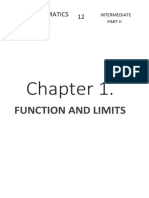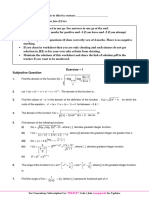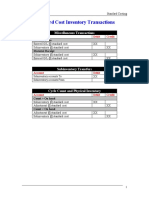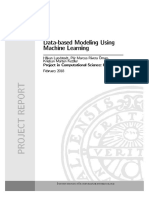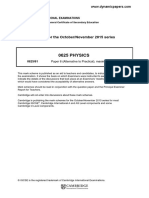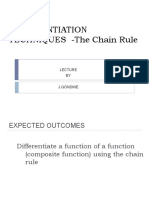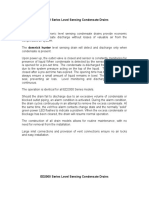Function (Mathematics)
Solution
1−x
1. (A) Given expression is 2f(x − 1) − f ( )=x
x
1 1 1 1−x 1
Replace x by x, we get: 2f (x − 1) − f(x − 1) = x ⇒ 2f ( ) − f(x − 1) = x
x
1−x
Eliminate f ( ) from (i) and (ii), we get :
x
1 1
f(x − 1) = (2x + )
3 x
1 1
Replace x by x + 1 to get: f(x) = 3 [2(1 + x) + 1+x]
2. (C) f(x + f(x)) = 4f(x)
Put x = 1, f(1 + f(1)) = 4f(1) ⇒ f(1 + 4) = 4(4) ⇒ f(5) = 16
Again put x = 5
f(5 + 16) = 4f(5) ⇒ f(21) = 4(16) = 64
1 2 3 21
3. (C) f(2x) + f (11 + 2x) + f (11 + 2x) + f (11 + 2x) + ⋯ … + f (11 + 2x) = k
1
Now, 2x → 2x + 11
1 2 3 4 22
f (2x + ) + f (2x + ) + f (2x + ) + f (2x + ) + ⋯ … + f (2x + ) = k
11 11 11 11 11
On subtracting f(2x) = f(2x + 2)
4. (B) h(x) = log10 x = ∑89 ∘
n=1 log10 (tan n )
= log10 tan 1∘ + log10 tan 2∘ + log10 tan 3∘ + log10 tan 4∘ + ⋯ . +log10 tan 89∘
= log10 (tan 1∘ tan 2∘ tan 3∘ tan 4∘ tan 5∘ … . . . tan 89∘ ) = log10 (1) = 0
1
5. (B) f(x) + 2f ( ) = 3x, x ≠ 0
x
1 3 6 2
f ( ) + 2f(x) = ; 3f(x) = − 3x; f(x) = − x
x x x x
2 −2
f(x) = f(−x) ⇒ − x = +x
x x
1
P(E1 ) = ⇒ x 2 = 2 ⇒ x = ±√2
6
6. (A) f(x) = Min {x, x 2 }
x x<0
f(x) = {x 2 0 ≤ x ≤ 1}
x x>1
7. (A) f(x) = Max {1 − x), (1 + x),2}
1−x x ≤ −1
See selected area : f(x) = { 2 −1 < x < 1}
1+x x≥1
1
DOWNLOAD
IIT SCHOOL APP NOW
� Function (Mathematics)
8. (A) Let us draw the graph of f(x).
9. (A)
10. (D)
log x log x log x 1 log x
11. (C) log 3 x + log √3x = 0 ⇒ 1 + 2 (log 3+log x) = 0
√ log 3+2log x
2 1
⇒ log x [ + ]=0
2log 3 + log x 2log 3 + 2log x
x > 0 log x = 0 or 4log 3 + 4log x = −2log 3 − log x
x = 1 or 5log x = −6log 3
1
One integral solution is x = 1 and One irrational solution x = 36/5
sin x |cos x|
12. (B) x ∈ [0,2π], y1 = |sin x| , y2 = cos x
π
When x ∈ (0, 2 )
sin x cos x
y1 = sin x , y2 = cos x = 1 ⇒ Identical
π
When x ∈ ( 2 , π)
y1 = 1, y2 = −1 ⇒ Not identical
3π
When x ∈ (π, )
2
y1 = −1, y2 = −1 ⇒ Identical
3π
When x ∈ ( 2 , 2π)
y1 = −1, y2 = 1 ⇒ Not identical
2
DOWNLOAD
IIT SCHOOL APP NOW
� Function (Mathematics)
√4−x2
13. (C) For f(x) to be defined, 1−x
> 0,4 − x2 > 0,1 − x ≠ 0
Since, √4 − x2 k0, we have 1 − x > 0 and 4 − x 2 > 0
⇒ x < 1 and (x − 2)(x + 2) < 0 ⇒ x < 1 and −2 < x < 2 ⇒ − 2 < x < 1
√4−x2 √4−x2
Since, −∞ < log ( ) < ∞ ⇒ − 1 ≤ sin [log ( )] ≤ 1 ∴ Range of f = [−1,1]
1−x 1−x
14. (B) Given, f(x) + 2f(1 − x) = x 2 + 2
Replace x by 1 − x in equation (i), we get :
f(1 − x) + 2f(x) = (1 − x)2 + 2
Now, multiplying equation (i) by 1 and equation (ii) by 2,
then subtracting each other, we get: −3f(x) = x 2 + 2 − 2(1 − x)2 − 4
(x − 2)2
⇒ 3f(x) = x 2 − 4x + 4 ⇒ f(x) =
3
|x|3 +|x|
15. (D) f(x) = − ( ) ⇒ f(x) < 0∀x ∈ R; Hence f(x) lies is III and IV quadrants only
1+x2
3
DOWNLOAD
IIT SCHOOL APP NOW
































